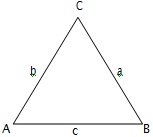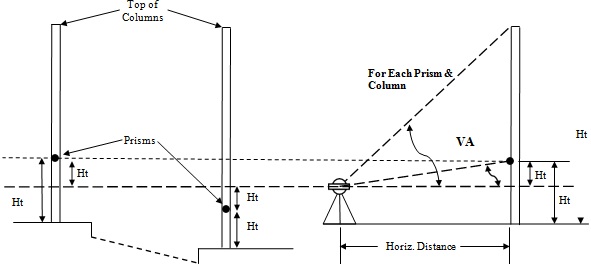Reference no: EM131395449
Part -1:
Aim
- To develop skills in setting up an instrument over a point using an optical plummet
- To develop skills in observing, booking and reducing angles.
- To consider the effect of measurement errors.
- To give experience in coordinate calculation.
Description
Field Work: Work in a group of 3. Equipment required: Total Station
Battery & Cable Tripod
Steel Tape
1. Measure the three angles and side lengths of a triangle defined by 3 inter-visible points/stations. Your points will be allocated.
2. At each point:
(i) Set up and centre the total station
(ii) Measure the angle between the other two points of the triangle.
- Each angle must be observed using at least 2 rounds of angles
- Ensure that the resulting angles agree.
- Remember that a round of angles consists of measurements on both face left and right, determine the mean value of the angle to each point.
- In order to sight on to the points, ask a group member to hold a pencil/pen on the mark and observe the tip.
3. Using a steel tape, measure the lengths of the 3 sides of the triangle. Use a procedure to minimise errors as developed in practical 2.
4. Calculations:
1. Add the three mean observed angles to give a total for the triangle.
- The sum should, of course, equal 180 degrees
2. Use the side lengths to calculate the 3 angles of the triangle using the cosine rule.

Cos A = (b2 + c2 - a2) / 2bc
3. Assign coordinates to one of your points (A) as 1000.000mE, 2000.000mN. Assume the bearing to another point (C) is 29° 17' 43" in order to calculate the coordinates of the other points (B & C).
4. Calculate the distance between these points (B & C) Distance2 = (EC - EB)2 + (NC - NB)2
Consider and Identify
- The difference between the calculated angles to the measured ones
- The effect on the angle for a error of 0.01 metre in a side length
- The effect of incorrect centring of the instrument over a point
- Sources of error in your measurements - analyse their size and effect on the results.
- How errors can be reduced or removed from the measurement process.
- Prepare a set of guidelines for high precision measurement practice in view of your experiences.
Part -2:
Aim
To develop skills in setting up a total station
To develop skills in observing, booking and reducing vertical angles To use vertical angles for the determination of height
Description
Task: Determine the difference in height and lengths of the "I" beams supporting the roof extensions of both East Building and West Building in University Square.
Field work: Working in a group of 3.
Equipment required: Total station,
Battery & Cable, Tripod
Method:
1. A prism will be located on a pole and fixed to the base of each "I" beam.
2. Set up total station at a point so that you are able to see the top and bottom of each "I" beams. Note Do not set up too close or your vertical angle will be too big to measure.
3. For each "I" beam:
a. Measure the height of the prism on the pole.
b. Measure the Vertical angle and Horizontal Distance to the prism.
c. Measure vertical angle to the top of the beam.
At least 2 rounds of vertical angles must be measured. Each round includes a measurement on each face.
Calculation:
1. Using the horizontal distances and vertical angles determine the differences in height between the instrument and each prism location. Apply the height of the prism on the pole to give the height of the ground with respect to the instrument.
2. Using the horizontal distance to the beam and the vertical angle to the top of the beam, calculate the difference in height to the top with respect to the instrument.
3. Calculate the length of each beam and difference in height of the top of the beams.
Consider and Identify:
- The sources of error in the measurements.
- The effect of an error in an angle measurement on the final height.
o E.g. Height difference for 10" change in vertical angle
- The effect of an error in a distance measurement on the final height.
o E.g. Height difference for 0.1 metre change in horizontal distance
- The effect of an error in both and angle and distance measurement on the final result.
- How errors can be reduced or removed from the measurement process.
Prepare a set of guidelines for high precision measurement practice in view of your experiences.

Land & Construction Surveying - Portfolio of Survey Projects
This component is a portfolio of reports on small practical projects and constitutes 35% of the total assessment for this module. Each week a practical/tutorial task will be given to apply the skills and techniques covered in the previous tasks and classes to meet the following learning outcomes:
- Interpret and make measurements on topographic maps
- Determine sources of error in measurement systems
- Use surveying equipment and calculation methods to minimise error propagation
- Analyse the precision of measurements and resulting values
- Evaluate graphical and numerical data
- Use instruments and measurement techniques according to surveying principles
- Record measurements
- Present results
- Navigate and interpret maps
- Work effectively in groups
- Manipulate numbers
The projects are designed to illustrate and aid understanding of the theory covered in the lectures. There is a requirement to take measurements or observations outside, on campus, together with calculations to obtain the results and an analysis of the results of each task. It is therefore important that you have warm and waterproof clothing & footwear, a reflective safety jacket, scientific calculator with degrees minutes seconds conversion, 3m steel builder's measuring tape and it is useful to have a scale ruler for measuring direct off scaled maps/plans.
Tasks
The portfolio to be submitted comprises the following practical exercises:
1. Observation and calculation of a Triangle: Angles and Distances (25%)
2. Vertical Angle (Trigonometrical) Heighting (25%)
3. Measured Building Survey (25%)
4. Long Section (25%)
You are required to carry out the measurements, perform calculations and prepare drawings as required by each project together with a report. Reports should include the following:
- Outline of the task including the equipment used
- Method of measurement
- The measurements / observation booking - ORIGINAL
- Results obtained, including any calculations
- Analysis of the task including responses to the items under "Consider and identify" on the practical sheet.
- Your conclusions on having completed the task.
Present your work neatly in a professional manner. When writing technical reports it is expected to split it up into sections with appropriate sub-headings. Use the 3rd person indefinite - that is to say do not state "I / we set up the instrument" but rather "The instrument was set up".
Indicate how calculations have been performed, including formulae, rather than just quote the result so that any mistakes can be located. Spreadsheets, such as Microsoft Excel, developed by yourself may be used but include a print out of the formulae.
Attachment:- survey assignment.zip